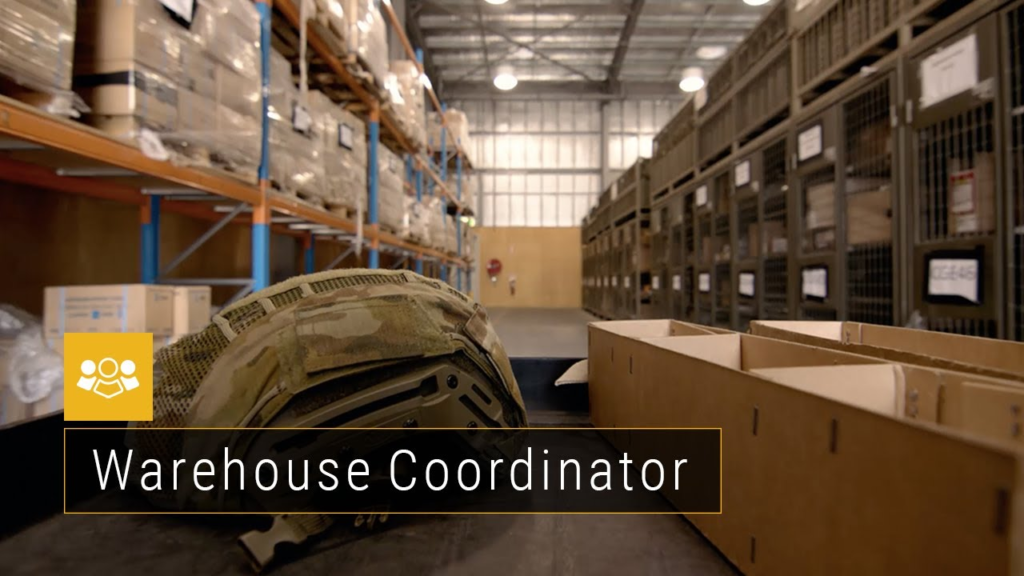Warehouse Claims Coordinator (1years diploma)
Warehouse Claims Coordinator click here
Brief Job Description
Warehouse Claims Coordinators are also know as Warehouse Claims Processors. Individuals in this role are responsible for receiving claims, assessing the goods concerned to ensure the claim is genuine and
estimating the reimbursable amount. They are also required to verify all the documents, send the claims to the insurance companies and provide detailed reports to the management.

Personal Attributes
This job requires the individual to work well with his/her team and achieve joint goals. The individual must
be able to prioritize and execute tasks within scheduled time limits. The individual should be able to
maintain high concentration levels throughout his/her shift.
Minimum Educational Qualification &
Experience
12th Class with 6 Months of experience
relevant experience
OR
10th Class (+ ITI (2 years after Class 10th))
OR
10th Class (and pursuing continuous regular
schooling)
OR
Certificate-NSQF (Warehouse Associate –
Level 3) with 2 Years of experience relevant
experience
Minimum Level of Education for Training in
School
Pre-Requisite License or Training Training in inspecting and valuating damaged
goods.
Minimum Job Entry Age 18 Years
Last Reviewed On NA
Next Review Date NA
NSQC Approval Date
Version 3.0
Prepare for claims processing
Description
This unit is about preparing for processing claims
Elements and Performance Criteria
Understand the schedule and receive claim forms
To be competent, the user/individual on the job must be able to:
PC1. understand the work schedule for the day from the manager.
PC2. obtain the list of claims, the individual claim forms, the claims processing checklist and the
inspection checklist from the manager.
PC3. if there are any pending claims, understand how they are included in the schedule.
PC4. understand priorities (if any) among claims.
Gather required equipment and perform inspection
To be competent, the user/individual on the job must be able to:

PC5. collect and wear all the necessary personal protective equipment (ppe) as required by the
product or the environment.
PC6. get the camera, any testing equipment required such as vernier calipers, screw gauge,
densimeter, etc.
PC7. inspect the camera and testing equipment to ensure that they are in good working condition
PC8. perform a trial run and make any configuration adjustments to ensure that the testing
equipment are ready.
Knowledge and Understanding (KU)
The individual on the job needs to know and understand:
KU1. knowledge of organizational products and procedures
KU2. procedures for dealing with loss or damage to goods
KU3. risk and impact of not following defined procedures/work instructions
KU4. nature and characteristics of goods in the warehouse
KU5. knowledge of all relevant safety and security procedures
KU6. knowledge of Standard Operating Procedures (SOPs) and how to react in emergencies.
KU7. knowledge of how to process claims and how to deal with false claims.
KU8. knowledge of insurance companies the organization works with and their processes
KU9. knowledge of specifications desired for each product.
KU10. knowledge of testing equipment to be used to test the quarantined goods.
KU11. knowledge of how to used the testing equipment and how to take readings.
KU12. knowledge of how to decide on whether the claim is genuine or not based on the readings
taken.
KU13. ability to carry out visual inspection and determine if further testing is required.
KU14. types of workplace hazards that one can encounter on the job and safe operating practices.
KU15. knowledge of possible difficulties in claims processing
Generic Skills (GS)
User/individual on the job needs to know how to:
GS1. note down the readings from the testing equipment.
GS2. fill out inspection checklists and maintain records of claims investigated.
GS3. prepare detailed reports for management
GS4. read claim forms and understand the claim.
GS5. read manuals and understand the characteristics of different products
GS6. read safety manuals and safety signs on the warehouse floor
GS7. communicate clearly with managers and peers
GS8. regularly communicate with all employees in the chain of activities on the shop floor to
ensure activities are running smoothly
GS9. provide advice and guidance to peers and juniors
GS10. act objectively , rather than impulsively or emotionally when faced with difficult/stressful or
emotional situations
GS11. ability to make a judgment as to whether the claim is genuine or not.
GS12. adjust according to volume, capacity and manpower needs during peak and non-peak hours
GS13. prioritize and execute tasks within the scheduled time limits

GS14. maintain schedules and punctuality. avoid absenteeism.
GS15. be a team player and achieve joint goals
GS16. flexibility to re-assess schedule in case of delays/additional orders
GS17. understand the customer requirements and ensure that they are met.
GS18. identify trends/common causes for errors and suggest possible solutions to the warehouse
supervisor
GS19. handle day to day problems like delays, staffing shortage. etc.
GS20. suggest methods to streamline claims processing.
GS21. ability to assess the reimbursable amount for each claim.
GS22. ability to concentrate on task at hand and complete it without errors
Inspect goods and validate claims
Description
This OS unit is about inspecting goods and validating the claims.
Elements and Performance Criteria
Inspect the quarantined goods
To be competent, the user/individual on the job must be able to:
PC1. check the reason in the claim form and perform a visual inspection of the quarantined goods
PC2. perform visual inspection. use the testing equipment to verify the accuracy of the claim or
refer it to the quality assurance team if required.
PC3. note down the results of the tests and fill out inspection checklists.
PC4. form a hypothesis on the reason for the damage, the accuracy of the claim and estimate the
reimbursable amount
PC5. take photographs to use as evidence.
Conduct interviews, get expert opinions and segregate false claims
To be competent, the user/individual on the job must be able to:
PC6. interview the claimants, witnesses (if any), clients, suppliers or insurance companies to
understand the genuineness and the reason for the claim
PC7. discuss the cause of damage with workers who are experienced in the area or
industry/subject matter experts to validate the hypothesis

PC8. check whether the claims were filed within the allowable period and are not outdated.
PC9. separate genuine claims from false claims. if claims are false or outdated, escalate them to
the manager.
PC10. refer to earlier cases and previous claims that are similar for reference.
PC11. update client/claimant on status of claim through the process.
Clean up after inspection
To be competent, the user/individual on the job must be able to:
PC12. return any PPE used and the testing equipment used to the respective storage rack.
PC13. have the housekeeping staff dispose quarantined goods and clean up any spillage or
breakages that occurred while testing.
PC14. perform an inspection of the quarantine area to ensure that it is clean and safe.
Knowledge and Understanding (KU)
The individual on the job needs to know and understand:
KU1. knowledge of organizational products and procedures
KU2. procedures for dealing with loss or damage to goods+ad5:af14
KU3. risk and impact of not following defined procedures/work instructions
KU4. nature and characteristics of goods in the warehouse
KU5. knowledge of all relevant safety and security procedures
KU6. knowledge of Standard Operating Procedures (SOPs) and how to react in emergencies.
KU7. knowledge of how to process claims and how to deal with false claims.
KU8. knowledge of insurance companies the organization works with and their processes
KU9. knowledge of specifications desired for each product
KU10. knowledge of testing equipment to be used to test the quarantined goods
KU11. knowledge of how to used the testing equipment and how to take readings.
KU12. knowledge of how to decide on whether the claim is genuine or not based on the readings
taken.
KU13. ability to carry out visual inspection and determine if further testing is required.
KU14. types of workplace hazards that one can encounter on the job and safe operating practices.
KU15. knowledge of possible difficulties in claims processing
Generic Skills (GS)
User/individual on the job needs to know how to:
GS1. note down the readings from the testing equipment.
GS2. fill out inspection checklists and maintain records of claims investigated.
GS3. prepare detailed reports for management
GS4. read claim forms and understand the claim.
GS5. read manuals and understand the characteristics of different products.
GS6. read safety manuals and safety signs on the warehouse floor
GS7. communicate clearly with managers and peers

GS8. regularly communicate with all employees in the chain of activities on the shop floor to
ensure activities are running smoothly
GS9. provide advice and guidance to peers and juniors
GS10. act objectively , rather than impulsively or emotionally when faced with difficult/stressful or
emotional situations
GS11. ability to make a judgment as to whether the claim is genuine or not.
GS12. adjust according to volume, capacity and manpower needs during peak and non-peak hours
GS13. prioritize and execute tasks within the scheduled time limits
GS14. maintain schedules and punctuality. avoid absenteeism
GS15. be a team player and achieve joint goals
GS16. flexibility to re-assess schedule in case of delays/additional orders
GS17. understand the customer requirements and ensure that they are met.
GS18. identify trends/common causes for errors and suggest possible solutions to the warehouse
supervisor
GS19. handle day to day problems like delays, staffing shortage, etc.
GS20. suggest methods to streamline claims processing
GS21. ability to assess the reimbursable amount for each claim
GS22. ability to concentrate on task at hand and complete it without errors
Reporting and documentation
Description
This unit is about performing documentation and reporting.
Elements and Performance Criteria
Fill out forms and forward to insurance companies
To be competent, the user/individual on the job must be able to:
PC1. verify that all the documents required (assessment certificate, invoice/bill, claims and
insurance forms, etc.) in the claims processing checklist are present and genuine.
PC2. ensure that the claim amounts are within the maximum legally permitted range.
PC3. inform the claimant whether the claim would be processed or not, explain the maximum
permissible claim amounts and resolve any other issues
PC4. process the claim forms and forward them to the concerned insurance companies along with
evidence and recommendations.
Resolve any clarifications or issues raised by the insurance company or escalate them to the manager if
required
To be competent, the user/individual on the job must be able to:
PC5. prepare detailed reports about the results of the inspection, claim amounts, etc.
PC6. prepare a report with reasons why certain claims were considered false.
PC7. explain any difficulties or delays due to formalities, interaction with claimants, government or
other agencies and have them resolved.
PC8. provide a list of claims that are still being processed and the reasons for the delay in
processing.
PC9. resolve any clarifications or issues raised by the insurance company or escalate them to the
manager if required
Knowledge and Understanding (KU)
The individual on the job needs to know and understand:
KU1. knowledge of organizational products and procedures
KU2. procedures for dealing with loss or damage to goods
KU3. risk and impact of not following defined procedures/work instructions
KU4. nature and characteristics of goods in the warehouse
KU5. knowledge of all relevant safety and security procedures
KU6. knowledge of Standard Operating Procedures (SOPs) and how to react in emergencies.
KU7. knowledge of how to process claims and how to deal with false claims
KU8. knowledge of insurance companies the organization works with and their processes
KU9. knowledge of specifications desired for each product.

KU10. knowledge of testing equipment to be used to test the quarantined goods.
KU11. knowledge of how to used the testing equipment and how to take readings.
KU12. knowledge of how to decide on whether the claim is genuine or not based on the readings
taken
KU13. ability to carry out visual inspection and determine if further testing is required.
KU14. types of workplace hazards that one can encounter on the job and safe operating practices.
KU15. knowledge of possible difficulties in claims processing.
Generic Skills (GS)
User/individual on the job needs to know how to:
GS1. note down the readings from the testing equipment.
GS2. fill out inspection checklists and maintain records of claims investigated.
GS3. prepare detailed reports for management.
GS4. read claim forms and understand the claim.
GS5. read manuals and understand the characteristics of different products
GS6. read safety manuals and safety signs on the warehouse floor
GS7. communicate clearly with managers and peers
GS8. regularly communicate with all employees in the chain of activities on the shop floor to
ensure activities are running smoothly
GS9. provide advice and guidance to peers and juniors
GS10. act objectively , rather than impulsively or emotionally when faced with difficult/stressful or
emotional situations
GS11. ability to make a judgment as to whether the claim is genuine or not.
GS12. adjust according to volume, capacity and manpower needs during peak and non-peak hours
GS13. prioritize and execute tasks within the scheduled time limits
GS14. maintain schedules and punctuality. avoid absenteeism
GS15. be a team player and achieve joint goals
GS16. flexibility to re-assess schedule in case of delays/additional orders
GS17. understand the customer requirements and ensure that they are met.
GS18. identify trends/common causes for errors and suggest possible solutions to the warehouse
supervisor
GS19. handle day to day problems like delays, staffing shortage, etc.
GS20. suggest methods to streamline claims processing.
GS21. ability to assess the reimbursable amount for each claim.
GS22. ability to concentrate on task at hand and complete it without errors
Maintain Health, Safety and Security measures for processing
claims in the warehouse
Description
This unit is about maintaining Health, Safety and Security measures for processing claims in the
warehouse

Elements and Performance Criteria
To be competent, the user/individual on the job must be able to:
PC1. comply with safety regulations and procedures in case of fire hazards, bio-hazards, etc.
PC2. wear all safety equipment including protective gear, helmets etc. when checking
inbound/outbound consignments
PC3. follow organization procedures with respect to documentation
PC4. recognize and report unsafe conditions and practices.
PC5. in case of signs of any emergency situation or accident or breach of safety immediately follow
organizational protocol to deploy action
PC6. identify reasons for occurrence of incident
PC7. capture reasons and response/action taken into incident report/note to manager
PC8. report any deviations from standard protocol along with reasons (if any)
PC9. visually inspect the activity area and equipment for appropriate and safe condition.
Knowledge and Understanding (KU)
The individual on the job needs to know and understand:
KU1. knowledge of organizational products and procedures
KU2. procedures for dealing with loss or damage to goods
KU3. risk and impact of not following defined procedures/work instructions
KU4. knowledge of computer systems used for documentation in the organization.
KU5. knowledge of all relevant safety and security procedures
KU6. knowledge of Standard Operating Procedures (SOPs) and how to react in emergencies.
KU7. knowledge of how to prepare the required documents and the number of copies needed.
KU8. knowledge of transport companies the organization works with and their processes
KU9. knowledge of processes involved in inbound and outbound transport.
KU10. knowledge of legal requirements, rules and regulations to be followed while preparing forms
and documents
KU11. knowledge of each form required for inbound/outbound transport.
KU12. knowledge of details to be filled into each form.
KU13. knowledge to use the computer for electronic documentation
KU14. types of workplace hazards that one can encounter on the job and safe operating practices
KU15. knowledge of possible difficulties in documentation
Generic Skills (GS)
User/individual on the job needs to know how to:
GS1. note down details regarding documentation for each inbound and outbound consignment.
GS2. fill out forms, inspection checklists for inbound and outbound consignments.
GS3. prepare detailed reports for management.

GS4. read and follow instructions in the checklists
GS5. read and understand details required in the forms.
GS6. communicate clearly with managers and peers
GS7. regularly communicate with all employees to ensure activities are running smoothly
GS8. provide advice and guidance to peers and juniors
GS9. act objectively , rather than impulsively or emotionally when faced with difficult/stressful or
emotional situations
GS10. adjust according to volume, capacity and manpower needs during peak and non-peak hours
GS11. prioritize and execute tasks within the scheduled time limits
GS12. maintain schedules and punctuality. avoid absenteeism
GS13. be a team player and achieve joint goals
GS14. flexibility to re-assess schedule in case of delays/additional orders
GS15. understand the customer requirements and ensure that they are met.
GS16. identify trends/common causes for errors and suggest possible solutions to the transport
manager
GS17. help resolve any documentation issues faced by the truck drivers en route
GS18. handle day to day problems like delays, staffing shortage, etc.
GS19. suggest methods to streamline the documentation process.
GS20. ability to check that all the forms required in the checklist have been filled out and are
ready.
GS21. ability to concentrate on task at hand and complete it without errors
Employability Skills (60 Hours)
Description
This unit is about employability skills, Constitutional values, becoming a professional in the 21st Century,
digital, financial, and legal literacy, diversity and Inclusion, English and communication skills, customer
service, entrepreneurship, and apprenticeship, getting ready for jobs and career development.
Scope
The scope covers the following :
Introduction to Employability Skills
Constitutional values – Citizenship
Becoming a Professional in the 21st Century
Basic English Skills
Career Development & Goal Setting
Communication Skills
Diversity & Inclusion
Financial and Legal Literacy
Essential Digital Skills
Entrepreneurship
Customer Service
Getting ready for Apprenticeship & Jobs
Elements and Performance Criteria
Introduction to Employability Skills
To be competent, the user/individual on the job must be able to:
PC1. identify employability skills required for jobs in various industries
PC2. identify and explore learning and employability portals
Constitutional values – Citizenship
To be competent, the user/individual on the job must be able to:
PC3. recognize the significance of constitutional values, including civic rights and duties,
citizenship, responsibility towards society etc. and personal values and ethics such as
honesty, integrity, caring and respecting others, etc.
PC4. follow environmentally sustainable practices
Becoming a Professional in the 21st Century
To be competent, the user/individual on the job must be able to:
PC5. recognize the significance of 21st Century Skills for employment
PC6. practice the 21st Century Skills such as Self-Awareness, Behaviour Skills, time management,
critical and adaptive thinking, problem-solving, creative thinking, social and cultural
awareness, emotional awareness, learning to learn for continuous learning etc. in personal
and professional life
Basic English Skills
To be competent, the user/individual on the job must be able to:
PC7. use basic English for everyday conversation in different contexts, in person and over the
telephone
PC8. read and understand routine information, notes, instructions, mails, letters etc. written in
English
PC9. write short messages, notes, letters, e-mails etc. in English
Career Development & Goal Setting
To be competent, the user/individual on the job must be able to:
PC10. understand the difference between job and career
PC11. prepare a career development plan with short- and long-term goals, based on aptitude
Communication Skills
To be competent, the user/individual on the job must be able to:
PC12. follow verbal and non-verbal communication etiquette and active listening techniques in
various settings
PC13. work collaboratively with others in a team
Diversity & Inclusion
To be competent, the user/individual on the job must be able to:
PC14. communicate and behave appropriately with all genders and PwD
PC15. escalate any issues related to sexual harassment at workplace according to POSH Act
Financial and Legal Literacy
To be competent, the user/individual on the job must be able to:
PC16. select financial institutions, products and services as per requirement
PC17. carry out offline and online financial transactions, safely and securely
PC18. identify common components of salary and compute income, expenses, taxes, investments
etc
PC19. identify relevant rights and laws and use legal aids to fight against legal exploitation
Essential Digital Skills
To be competent, the user/individual on the job must be able to:
PC20. operate digital devices and carry out basic internet operations securely and safely
PC21. use e- mail and social media platforms and virtual collaboration tools to work effectively
PC22. use basic features of word processor, spreadsheets, and presentations
Entrepreneurship
To be competent, the user/individual on the job must be able to:
PC23. identify different types of Entrepreneurship and Enterprises and assess opportunities for
potential business through research
PC24. develop a business plan and a work model, considering the 4Ps of Marketing Product, Price,
Place and Promotion
PC25. identify sources of funding, anticipate, and mitigate any financial/ legal hurdles for the
potential business opportunity
Customer Service
To be competent, the user/individual on the job must be able to:
PC26. identify different types of customers
PC27. identify and respond to customer requests and needs in a professional manner.
PC28. follow appropriate hygiene and grooming standards
Getting ready for apprenticeship & Jobs
To be competent, the user/individual on the job must be able to:
PC29. create a professional Curriculum vitae (Résumé)
PC30. search for suitable jobs using reliable offline and online sources such as Employment
exchange, recruitment agencies, newspapers etc. and job portals, respectively
PC31. apply to identified job openings using offline /online methods as per requirement
PC32. answer questions politely, with clarity and confidence, during recruitment and selection
PC33. identify apprenticeship opportunities and register for it as per guidelines and requirements
Knowledge and Understanding (KU)
The individual on the job needs to know and understand:
KU1. need for employability skills and different learning and employability related portals
KU2. various constitutional and personal values
KU3. different environmentally sustainable practices and their importance
KU4. Twenty first (21st) century skills and their importance
KU5. how to use English language for effective verbal (face to face and telephonic) and written
communication in formal and informal set up
KU6. importance of career development and setting long- and short-term goals
KU7. about effective communication
KU8. POSH Act
KU9. Gender sensitivity and inclusivity
KU10. different types of financial institutes, products, and services
KU11. how to compute income and expenditure
KU12. importance of maintaining safety and security in offline and online financial transactions
KU13. different legal rights and laws
KU14. different types of digital devices and the procedure to operate them safely and securely
KU15. how to create and operate an e- mail account and use applications such as word processors,
spreadsheets etc.
KU16. how to identify business opportunities
KU17. types and needs of customers
KU18. how to apply for a job and prepare for an interview
KU19. apprenticeship scheme and the process of registering on apprenticeship portal
Generic Skills (GS)
User/individual on the job needs to know how to:
GS1. read and write different types of documents/instructions/correspondence
GS2. communicate effectively using appropriate language in formal and informal settings
GS3. behave politely and appropriately with all
GS4. how to work in a virtual mode






